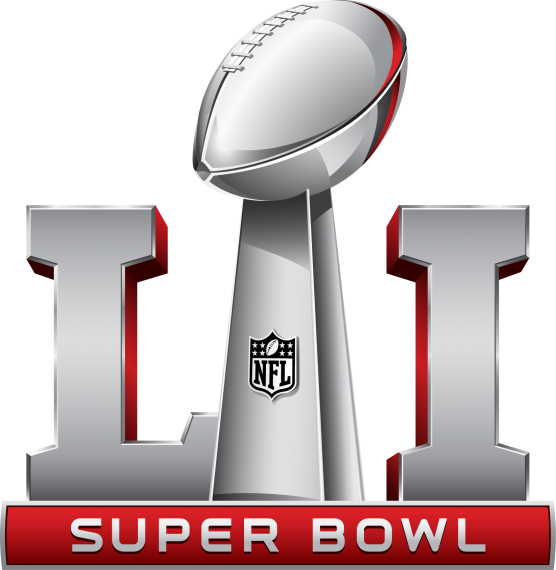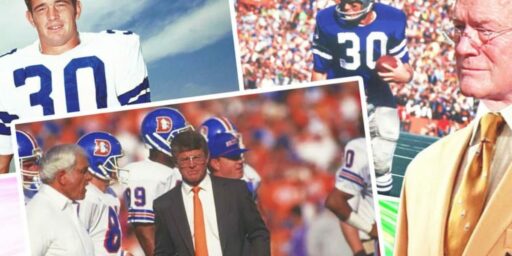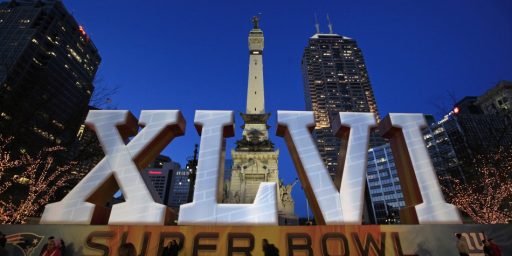Super Bowl Commercial Prices Hit $5,000,000 For 30 Seconds Of Ad Time
A Super Bowl ad will cost you a cool $5,000,000 for thirty seconds.
If you want to buy commercial time during this year’s Super Bowl, you’ll have to fork over a record amount of money yet again:
The average cost of a 30-second ad for the Super Bowl crept up to $5 million this year, according to ad buyers, from an estimated $4.8 million last year. Brands, eager to get their money’s worth, may spend anywhere from 25 percent of that cost to the same amount on marketing tied to the ads themselves, said Mary Scott, president at UEG, a sports and entertainment marketing agency.
“Even though the spots have incredible viewership — as much as the game itself — you never know,” Ms. Scott said, adding that she recommends clients spend an amount equal to at least 25 percent of the cost on promotions related to their Super Bowl ad. “There’s become more of a game around the game in terms of ensuring that really pays off in a big way.”
The willingness of companies to pay record prices for Super Bowl ads while simultaneously spending more to promote them shows how coveted consumer attention has become in the age of smartphones and social media. It can also be a mind-bending thought experiment, given that the ads are attempts to sell consumers on a product or brand.
As recently as 2011, it was relatively novel for companies like Volkswagen to share teasers and full versions of their ads before the Super Bowl. Now, the main question for companies seems to be how early to start. More brands are choosing a “drumbeat” approach over one big moment, said Tara Walpert Levy, the vice president of agency and media solutions at YouTube, which has seen more companies prerelease and promote Super Bowl ads over the past few years. (YouTube is celebrating the 10th year of its AdBlitz competition, which encourages viewers to vote for their favorite Super Bowl ads, almost all of which are released and seen widely before the game.)
Social media is also far more developed as an industry than it was several years ago, making it harder for agencies to maneuver their way into online buzz without buying a spot, as Old Spice did in 2010. The platforms “have caught on and have monetized all the extensions around the Super Bowl,” said Lawrence Teherani-Ami, the media director for North America at the ad agency Wieden & Kennedy.
“Whether it’s Twitter, Facebook, Instagram or YouTube, they all have different types of buys you can make,” he said. “The Super Bowl has created a cottage industry for other media companies to take advantage of it as well.”
Starting in January, public relations firms and executives at large brands offered the news media previews or exclusive peeks at their commercials, as long as they agreed not to publish the ads or information about them until a specific time — say, Jan. 26 at 6 p.m. for Mercedes-Benz, or Jan. 31 at 8 p.m. for Buick. Often, the ads were just one part of a broader brand campaign, bolstered by celebrities or new products, with executives ready for interviews.
Obviously, companies are willing to pay this amount of money for a commercial because it puts their product(s) in front of a huge audience of people that includes not only folks watching the game, but also people who watch almost any form of television before or after the game itself. Starting in the next day or two, when many companies will offer “sneak peaks” at their commercials, they will also get access to audiences who watch cable news stations, broadcast network morning shows, and entertainment news programs that will cover the commercial as much as they cover the game itself, if not more so. They’ll get additional coverage from social media and in post-game coverage next Monday when highlights of the commercials will be as common a sight as highlights from the game itself. Given the potential audience this gives them access to, $5,000,000 for thirty seconds of your time make a lot more sense than it does in isolation.
All that being said, Fortune reported earlier this month that Fox, which is airing Super Bowl LI this year, has found booking commercials to be a bit of a harder sell. Part of the reason is due to the very fact that makes the idea of running an ad during the Super Bowl so attractive in the first place, namely the fact that nationwide exposure to big audience carries downside risk as well as potential benefits:
A Super Bowl ad can boost a brand, create excitement, spawn conversations and drive sales. These potential benefits are part of the reason companies can justify the cost. But a Super Bowl spot can also create problems; the event receives so much attention and scrutiny that a Super Bowl advertiser can find itself at the heart of a negative PR nightmare.
This downside risk has become very apparent in recent years, and general uncertainty may only enhance brand sensitivity to risk, and why people are more sensitive to them.
Recall Nationwide, which in 2015 received plenty of criticisms for airing a spot featuring a dead child. Instead of enhancing its brand among consumers, the Super Bowl ad damaged it among many. In 2011, HomeAway was forced to apologize for its Super Bowl ad that included a baby being smushed against a glass wall. That same year, Groupon was embarrassed by its ad that made light of oppression in Tibet.
In this way, Super Bowl advertising is exceptional. People don’t usually get too upset about a single commercial running on Survivor or CSI. Careers don’t end due to a mediocre execution, but agencies and clients have parted ways, and even been sued, over a single disappointing Super Bowl spot.
This would seem to be an even bigger risk given the prevalence of social media and the fact that outlets such as Twitter and Facebook have become places where viewers, who usually have their phones, tablets, or laptops nearby while watching the big game, can either make or break a campaign that a company and an advertising agency have gambled millions. Just as people react to the plays on the field in real time, they judge the commercials that way too, and the negative reaction to an advertisement deemed to be controversial, offensive, or just plain bad can spread around the country and the world in a matter of minutes. That reaction itself would likely become news the next morning as well, and what seemed like a surefire bet for getting exposure to the biggest television audience of the year can end in disaster for the people responsible for just thirty seconds of programming.







I’d love to see Mark Zuckerberg, Bill Gates or Tim Cook finance a one minute American Civil Liberties Union spot.
To be honest, I doubt that the network would have the courage to air such a spot. But that would be great theater. Trump’s head would explode, Agent Orange all over the Oval Office.
I always wonder about Super Bowl commercials, considering I suspect the bulk of the Superbowl watching population takes the break when ads come on to use the loo.
@grumpy realist:
“I suspect the bulk of the Superbowl watching population takes the break when ads come on to use the loo.”
Unfortunately, the people who I watch the Super Bowl with are majority female and non-football fans, so the reverse is true. There is far higher interest in the commercials and the halftime show than the game.
It is now all about the commercials and the halftime show. The game itself is secondary.
Different groups are doing petitions to have a change in the halftime show. Seems some want Lady Gaga off and their preference put in. Mine is Willie Nelson. Now who can argue with that ?
Some day a large corporation or billionaire will buy up all the time and have it commercial free.
@grumpy realist:
God no. Remember all those years when the Super Bowl was a blowout? The ads were the only things worth watching. And when my family and I were overseas, we went to great lengths to try to get a feed with ads (it was easy to get a feed without ads, or with different, local ads)
Five big for thirty seconds? I tried watching a regular season game this year, and after every two-three plays they showed seven ads. I calculate ad revenue to be close to a billion for the SB. I am looking forward to Lady Gaga.
I’m here to speak for a minority:
Those who could not care less.
Yes, we’re the ones that rarely speak out: born without the give-a-rats-ass-about-sports gene.
Sure there’s not many of us, but we are there.
Baseballl game? Sure we’ll go ! but it’s for the sunshine and a hot dog. Don’t ask us who’s playing.
Superbowl? An AWESOME day… to be skiing or snowboarding (because everyone else is in front of a TV eating greasy chicken wings).
So buy those $100 sweatshirts, drink that $10 small plastic cup of cheap draft beer, and pay the scalper way over face value for your tickets.
We’ll be the one that will hear you tell your tale on Monday.
And not care at all.
And yet, raising the minimum wage to $15/hr. over a period of 5-8 years with bring the economy crashing down to a fiery doom. (Sigh…)